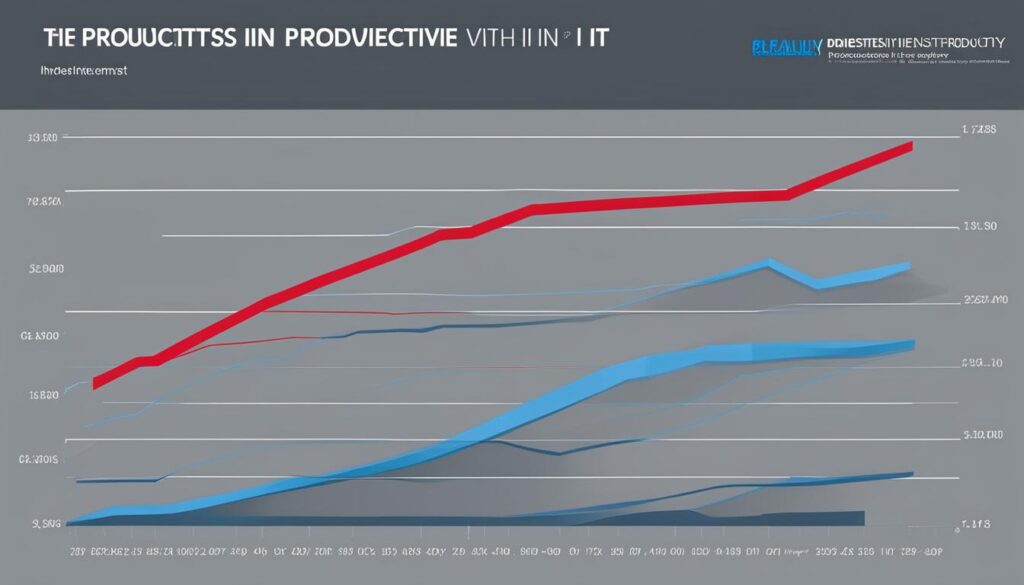Welcome to our article on the productivity paradox of information technology. In this section, we will delve into the concept of the IT productivity paradox and explore its significance in the business world. The productivity paradox, also known as the Solow computer paradox, refers to the observation that increased investment in information technology (IT) does not always lead to a corresponding increase in productivity.
Historically, empirical evidence from the 1970s to the early 1990s has supported this paradox, showing that the expected return on investment in IT for productivity was only 1%, compared to the 3-4% return seen in mechanization and automation. However, recent studies have revealed that companies heavily investing in IT can experience significant productivity increases, challenging the long-standing belief in the productivity paradox.
Contents
- 1 Defining Information Technology
- 2 The Development of the Productivity Paradox
- 3 The Productivity Paradox in Costing and Studies
- 4 Conclusion
- 5 FAQ
- 5.1 What is the productivity paradox of information technology?
- 5.2 What is the impact of IT on productivity?
- 5.3 How does IT adoption affect productivity?
- 5.4 What is the relationship between IT investment and productivity?
- 5.5 How does information technology impact business productivity?
- 5.6 What is the IT productivity gap?
- 6 Source Links
Key Takeaways:
- The productivity paradox refers to the observation that increased investment in IT does not always lead to a corresponding increase in productivity.
- Historical evidence showed a minimal return on investment in IT for productivity, but recent studies have challenged this notion.
- There are several theories and explanations for the productivity paradox, including measurement errors and delayed productivity gains.
- Companies heavily investing in IT have shown significant productivity increases in recent years.
- The IT productivity paradox is a complex phenomenon that requires further study and understanding.
Defining Information Technology
Information technology (IT) is a broad field that encompasses the study, design, development, implementation, support, and management of computer-based information systems. These systems include software applications and computer hardware, which organizations invest in to enhance their operations and achieve their goals. IT involves various components such as computers, databases, networks, software, and other computer-related materials.
Investing in IT can have a significant impact on productivity, although the immediate profitability may not always be evident. Historically, from the 1960s to the 1980s, there was evidence suggesting that investing in IT did not yield the expected gains in productivity. This phenomenon gave rise to the concept of the productivity paradox of information technology.
However, recent studies have shown that companies heavily investing in IT have experienced notable increases in productivity. This newfound understanding challenges the notion that IT investments may not always deliver the expected boost in productivity.
“The impact of IT on productivity has long been a topic of debate. However, companies embracing IT and harnessing its potential have witnessed significant improvements in productivity.”
Impact of IT on Productivity
The adoption of IT has the potential to transform business operations and improve productivity in several ways:
- Automation: IT enables the automation of routine tasks, freeing up time for employees to focus on higher-value activities. This streamlines processes and increases efficiency.
- Data Management: IT facilitates the collection, storage, and analysis of large volumes of data, allowing organizations to make informed decisions and identify areas for improvement.
- Collaboration: Information technology enables seamless communication and collaboration across teams, departments, and even geographical locations, enhancing productivity through effective knowledge sharing and teamwork.
- Access to Information: IT provides easy access to relevant information, reducing the time and effort required to search for and retrieve data. This improves decision-making and accelerates workflow.
By leveraging these benefits, companies can unlock the full potential of IT and drive increased productivity across their operations.
| Year | Level of IT Adoption | Productivity Growth |
|---|---|---|
| 1990 | Low | 1.9% |
| 2000 | Medium | 3.7% |
| 2010 | High | 5.5% |
The Development of the Productivity Paradox
The productivity paradox unfolded in multiple stages, with evolving perceptions of the relationship between IT investment and productivity. Initially, there was a widespread belief that information technology (IT) would completely replace human labor, leading to high expectations of increased productivity. However, as the late 1970s approached, it became evident that the outcomes of IT investment were not living up to these initial hopes and projections. Despite this realization, companies continued to invest in IT without proper evaluation, relying solely on return on investment calculations.
By the early 1980s, companies began to recognize that IT should be utilized strategically rather than focusing solely on productivity gains. This shift in mindset marked a crucial turning point in the trajectory of IT investments. Companies started viewing IT as a tool that could be leveraged to achieve broader organizational goals and objectives, expanding beyond the narrow scope of productivity enhancement. Consequently, the spotlight shifted towards utilizing IT investments for management information systems, laying the foundation for advancements in this field during the late 1980s and beyond.
“The true potential of IT lies in its strategic utilization, rather than being solely confined to productivity gains.”
During this period, several theories and explanations emerged to shed light on the productivity paradox. Scholars and researchers proposed various factors that contributed to the perceived disconnect between IT investment and productivity outcomes. These factors ranged from measurement errors and delays in realizing productivity gains to the challenges associated with accurately assessing the impact of IT on business performance.
In recent years, the focus of IT investment has shifted towards telecommunications. While expectations regarding productivity increases have been tempered, organizations continue to recognize the value of investing in IT as a means of improving operational efficiency and effectiveness. Despite the ongoing challenges and complexities, the realm of IT investment and its impact on business productivity remains a subject of keen interest and research.

Stay tuned for the next section, where we explore the productivity paradox in the context of costing and studies.
The Productivity Paradox in Costing and Studies
American manufacturers’ efforts to improve productivity through IT investments have often been disappointing. Despite their pursuit of productivity, the results have been paradoxical, with productivity becoming more elusive. Studies have shown a negative correlation between increased IT spending and productivity in the manufacturing sector. Researchers have also highlighted the stagnation of white-collar productivity, especially in the service sector.
However, it is important to note that the correlation between IT spending and productivity at the level of the entire economy may not be compelling due to various factors influencing productivity. Additionally, the assessment of office worker productivity is challenging, as it is difficult to measure directly.
Conclusion
The IT productivity paradox is a complex phenomenon that has puzzled researchers for decades. Initially, it seemed that increased investment in IT did not translate into significant gains in productivity. However, recent studies have revealed a different story, demonstrating that companies that heavily invest in IT can experience notable increases in productivity.
This paradox unfolded in various stages, reflecting shifts in expectations and our understanding of IT’s role in driving productivity. Initially, there was a belief that IT would replace human labor entirely, leading to high hopes for increased productivity. Yet, as time went on, it became clear that the results were not as expected.
While there are still gaps in how we measure and evaluate IT’s contribution to productivity, it is evident that IT has the potential to drive significant improvements when strategically implemented. By leveraging IT investments in a thoughtful manner, businesses can bridge the IT productivity gap and unlock new levels of efficiency, effectiveness, and growth.
FAQ
What is the productivity paradox of information technology?
The productivity paradox, also known as the Solow computer paradox, refers to the observation that increased investment in information technology (IT) does not always lead to a corresponding increase in productivity.
What is the impact of IT on productivity?
The impact of IT on productivity can vary. While there was evidence in the past that investing in IT did not yield expected gains in productivity, recent studies have shown that companies heavily investing in IT have experienced significant increases in productivity.
How does IT adoption affect productivity?
The relationship between IT adoption and productivity is complex. While there has been a historical productivity paradox where increased investment in IT did not yield expected productivity gains, recent studies have shown that strategic IT adoption can lead to substantial increases in productivity for businesses.
What is the relationship between IT investment and productivity?
The relationship between IT investment and productivity is not always straightforward. While there has been evidence of a productivity paradox in the past, recent studies have shown significant increases in productivity in companies that heavily invested in IT.
How does information technology impact business productivity?
Information technology has the potential to significantly impact business productivity when strategically implemented. While there have been debates and studies on the productivity paradox of IT, recent evidence suggests that companies heavily investing in IT have experienced substantial productivity increases.
What is the IT productivity gap?
The IT productivity gap refers to the discrepancy between the expected productivity gains from investment in information technology and the actual realized gains. While there has been a historical productivity paradox, recent studies have shown that strategic IT investments can lead to significant improvements in business productivity.




